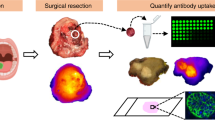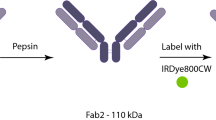Abstract
Purpose
The development of molecularly targeted tracers is likely to improve the accuracy of diagnostic, screening, and therapeutic tools. Despite the many therapeutic antibodies that are FDA-approved with known toxicity, only a limited number of antibody-dye conjugates have been introduced to the clinic. Thorough evaluation of the safety, stability, and pharmacokinetics of antibody conjugates in the clinical setting compared with their parental components could accelerate the clinical approval of antibodies as agents for molecular imaging. Here we investigate the safety and stability of a near-infrared fluorescent dye (IRDye800CW) conjugated panitumumab, an approved therapeutic antibody, and report on the product stability, pharmacokinetics, adverse events, and QTc interval changes in patients.
Procedures
Panitumumab-IRDye800CW was made under good manufacturing practice (GMP) conditions in a single batch on March 26, 2014, and then evaluated over 4.5 years at 0, 3, and 6 months, and then at 6-month intervals thereafter. We conducted early phase trials in head and neck, lung, pancreas, and brain cancers with panitumumab-IRDye800CW. Eighty-one patients scheduled to undergo standard-of-care surgery were infused with doses between 0.06 to 2.83 mg/kg of antibody. Patient ECGs, blood samples, and adverse events were collected over 30-day post-infusion for analysis.
Results
Eighty-one patients underwent infusion of the study drug at a range of doses. Six patients (7.4 %) experienced an adverse event that was considered potentially related to the drug. The most common event was a prolonged QTc interval which occurred in three patients (3.7 %). Panitumumab-IRDye800CW had two OOS results at 42 and 54 months while meeting all other stability testing criteria.
Conclusions
Panitumumab-IRDye800CW was safe and stable to administer over a 54-month window with a low rate of adverse events (7.4 %) which is consistent with the rate associated with panitumumab alone. This data supports re-purposing therapeutic antibodies as diagnostic imaging agents with limited preclinical toxicology studies.



Similar content being viewed by others
References
van Keulen S, Nishio N, Fakurnejad S, Birkeland A, Martin BA, Lu G, Zhou Q, Chirita SU, Forouzanfar T, Colevas AD, van den Berg NS, Rosenthal EL (2019) The clinical application of fluorescence-guided surgery in head and neck cancer. J Nucl Med 60:758–763. https://doi.org/10.2967/jnumed.118.222810
He K, Zhou J, Yang F, Chi C, Li H, Mao Y, Hui B, Wang K, Tian J, Wang J (2018) Near-infrared intraoperative imaging of thoracic sympathetic nerves: from preclinical study to clinical trial. Theranostics 8(2):304–313
Nishio N, van den Berg NS, van Keulen S et al (2019) Optical molecular imaging can differentiate metastatic from benign lymph nodes in head and neck cancer. Nat Commun 10(1):1–10
Haslam A, Prasad V (2019) Estimation of the percentage of US patients with cancer who are eligible for and respond to checkpoint inhibitor immunotherapy drugs. JAMA Netw Open 2(5):e192535–e192535
Ventola CL (2017) Cancer immunotherapy, part 3: challenges and future trends. Pharm Ther 42(8):514–521
Sambi M, Bagheri L, Szewczuk MR (2019) Current challenges in cancer immunotherapy: multimodal approaches to improve efficacy and patient response rates. Gupta SC, ed. J Oncol. https://doi.org/10.1155/2019/4508794
Conner KP, Rock BM, Kwon GK, Balthasar JP, Abuqayyas L, Wienkers LC, Rock DA (2014) Evaluation of near infrared fluorescent labeling of monoclonal antibodies as a tool for tissue distribution. Drug Metab Dispos 42(11):1906–1913
Lu G, Fakurnejad S, Martin BA, van den Berg NS, van Keulen S, Nishio N, Zhu AJ, Chirita SU, Zhou Q, Gao RW, Kong CS, Fischbein N, Penta M, Colevas AD, Rosenthal EL (2020) Predicting therapeutic antibody delivery into human head and neck cancers. Clin Cancer Res 26:2582–2594. https://doi.org/10.1158/1078-0432.CCR-19-3717
Knutson S, Raja E, Bomgarden R, Nlend M, Chen A, Kalyanasundaram R, Desai S (2016) Development and evaluation of a fluorescent antibody-drug conjugate for molecular imaging and targeted therapy of pancreatic cancer. PLoS One 11(6):e0157762
Bensch F, van der Veen EL, Lub-de Hooge MN, Jorritsma-Smit A, Boellaard R, Kok IC, Oosting SF, Schröder CP, Hiltermann TJN, van der Wekken AJ, Groen HJM, Kwee TC, Elias SG, Gietema JA, Bohorquez SS, de Crespigny A, Williams SP, Mancao C, Brouwers AH, Fine BM, de Vries EGE (2018) 89Zr-atezolizumab imaging as a non-invasive approach to assess clinical response to PD-L1 blockade in cancer. Nat Med 24(12):1852–1858
Giusti RM, Shastri KA, Cohen MH, Keegan P, Pazdur R (2007) FDA drug approval summary: panitumumab (Vectibix). Oncologist 12(5):577–583
Bethune G, Bethune D, Ridgway N, Xu Z (2010) Epidermal growth factor receptor (EGFR) in lung cancer: an overview and update. J Thorac Dis 2(1):48–51
Kalyankrishna S, Grandis JR (2006) Epidermal growth factor receptor biology in head and neck cancer. J Clin Oncol 24(17):2666–2672
Oliveira-Cunha M, Newman WG, Siriwardena AK (2011) Epidermal growth factor receptor in pancreatic cancer. Cancers. 3(2):1513–1526
Saadeh FS, Mahfouz R, Assi HI (2018) EGFR as a clinical marker in glioblastomas and other gliomas. Int J Biol Markers 33(1):22–32
Adams KE, Ke S, Kwon S, Liang F, Fan Z, Lu Y, Hirschi K, Mawad ME, Barry MA, Sevick-Muraca EM (2007) Comparison of visible and near-infrared wavelength-excitable fluorescent dyes for molecular imaging of cancer. J Biomed Opt 12(2):024017
Marshall MV, Draney D, Sevick-Muraca EM, Olive DM (2010) Single-dose intravenous toxicity study of IRDye 800CW in Sprague-Dawley rats. Mol Imaging Biol 12(6):583–594
ter Weele EJ, Terwisscha van Scheltinga AGT, Linssen MD et al (2016) Development, preclinical safety, formulation, and stability of clinical grade bevacizumab-800CW, a new near infrared fluorescent imaging agent for first in human use. Eur J Pharm Biopharm 104:226–234
Zinn KR, Korb M, Samuel S, Warram JM, Dion D, Killingsworth C, Fan J, Schoeb T, Strong TV, Rosenthal EL (2015) IND-directed safety and biodistribution study of intravenously injected cetuximab-IRDye800 in Cynomolgus macaques. Mol Imaging Biol 17(1):49–57
Bhattacharyya S, Patel N, Wei L, et al. (2014) Synthesis and biological evaluation of panitumumab-IRDye800 conjugate as a fluorescence imaging probe for EGFR-expressing cancers
[Internet] U.S. Food and Drug Administration (2019) E14 clinical evaluation of QT/QTc interval prolongation and proarrhythmic potential for non-antiarrhythmic drugs
Aldrich MB, Wang X, Hart A, Kwon S, Sampath L, Marshall MV, Sevick-Muraca EM (2011) Assessment of free dye in solutions of dual-labeled antibody conjugates for in vivo molecular imaging. Mol Imaging Biol 13(1):32–42
Gao RW, Teraphongphom N, de Boer E, Berg NS, Divi V, Kaplan MJ, Oberhelman NJ, Hong SS, Capes E, Colevas AD, Warram JM, Rosenthal EL (2018) Safety of panitumumab-IRDye800CW and cetuximab-IRDye800CW for fluorescence-guided surgical navigation in head and neck cancers. Theranostics. 8(9):2488–2495
Giusti RM, Shastri KA, Cohen MH, Keegan P, Pazdur R (2007) FDA drug approval summary: panitumumab (Vectibix™). Oncologist 12(5):577–583
Day KE, Beck LN, Deep NL, Kovar J, Zinn KR, Rosenthal EL (2013) Fluorescently labeled therapeutic antibodies for detection of microscopic melanoma. Laryngoscope 123(11):2681–2689
Lamberts LE, Koch M, de Jong JS, Adams ALL, Glatz J, Kranendonk MEG, Terwisscha van Scheltinga AGT, Jansen L, de Vries J, Lub-de Hooge MN, Schröder CP, Jorritsma-Smit A, Linssen MD, de Boer E, van der Vegt B, Nagengast WB, Elias SG, Oliveira S, Witkamp AJ, Mali WPTM, van der Wall E, van Diest PJ, de Vries EGE, Ntziachristos V, van Dam GM (2017) Tumor-specific uptake of fluorescent bevacizumab–IRDye800CW microdosing in patients with primary breast cancer: a phase I feasibility study. Clin Cancer Res 23(11):2730–2741
Marston JC, Kennedy GD, Lapi SE, Hartman YE, Richardson MT, Modi HM, Warram JM (2019) Panitumumab-IRDye800CW for fluorescence-guided surgical resection of colorectal cancer. J Surg Res 239:44–51
Vázquez-Rey M, Lang DA (2011) Aggregates in monoclonal antibody manufacturing processes. Biotechnol Bioeng 108(7):1494–1508
Rosenberg AS (2006) Effects of protein aggregates: an immunologic perspective. AAPS J 8(3):E501–E507
Roberts CJ. (2014) Protein aggregation and its impact on product quality. Curr Opin Biotechnol 0:211–217, 30
Szabó Á, Szendi-Szatmári T, Ujlaky-Nagy L, Rádi I, Vereb G, Szöllősi J, Nagy P (2018) The effect of fluorophore conjugation on antibody affinity and the photophysical properties of dyes. Biophys J 114(3):688–700
Schobel U, Egelhaaf H-J, Fröhlich D, Brecht A, Oelkrug D, Gauglitz G (2000) Mechanisms of fluorescence quenching in donor—acceptor labeled antibody—antigen conjugates. J Fluoresc 10(2):147–147
Fakih M, Vincent M (2010) Adverse events associated with anti-EGFR therapies for the treatment of metastatic colorectal cancer. Curr Oncol 17(Suppl 1):S18–S30
Amgen Inc (2009) Vectibix (panitumumab) [package insert]. Thousand Oaks, CA
Rosenthal EL, Warram JM, de Boer E, Chung TK, Korb ML, Brandwein-Gensler M, Strong TV, Schmalbach CE, Morlandt AB, Agarwal G, Hartman YE, Carroll WR, Richman JS, Clemons LK, Nabell LM, Zinn KR (2015) Safety and tumor-specificity of cetuximab-IRDye800 for surgical navigation in head and neck cancer. Clin Cancer Res Off J Am Assoc Cancer Res 21(16):3658–3666
Linssen MD, ter Weele EJ, Allersma DP, Lub-de Hooge MN, van Dam GM, Jorritsma-Smit A, Nagengast WB (2019) Roadmap for the development and clinical translation of optical tracers cetuximab-800CW and trastuzumab-800CW. J Nucl Med 60(3):418–423
Scheuer W, van Dam GM, Dobosz M, Schwaiger M, Ntziachristos V (2012) Drug-based optical agents: infiltrating clinics at lower risk. Sci Transl Med 4(134):134ps11
Tummers WS, Warram JM, Tipirneni KE, Fengler J, Jacobs P, Shankar L, Henderson L, Ballard B, Pfefer TJ, Pogue BW, Weichert JP, Bouvet M, Sorger J, Contag CH, Frangioni JV, Tweedle MF, Basilion JP, Gambhir SS, Rosenthal EL (2017) Regulatory aspects of optical methods and exogenous targets for cancer detection. Cancer Res 77(9):2197–2206
Funding
We acknowledge the support of the NCI NExT Program, NIH R01 CA190306-01, the Stanford Molecular Imaging Scholars (SMIS) program (NIH T32CA118681), and the Netherlands Organization for Scientific Research (Rubicon; 019.171LW.022).
Author information
Authors and Affiliations
Corresponding author
Ethics declarations
Conflict of Interest
Eben Rosenthal has equipment loans from LI-COR. The authors declare that they have no conflict of interest.
Additional information
Publisher’s Note
Springer Nature remains neutral with regard to jurisdictional claims in published maps and institutional affiliations.
Jacqueline Pei and Georgina Juniper share first authorship
Electronic supplementary material
ESM 1
(DOCX 14 kb)
Rights and permissions
About this article
Cite this article
Pei, J., Juniper, G., van den Berg, N.S. et al. Safety and Stability of Antibody-Dye Conjugate in Optical Molecular Imaging. Mol Imaging Biol 23, 109–116 (2021). https://doi.org/10.1007/s11307-020-01536-2
Received:
Revised:
Accepted:
Published:
Issue Date:
DOI: https://doi.org/10.1007/s11307-020-01536-2




